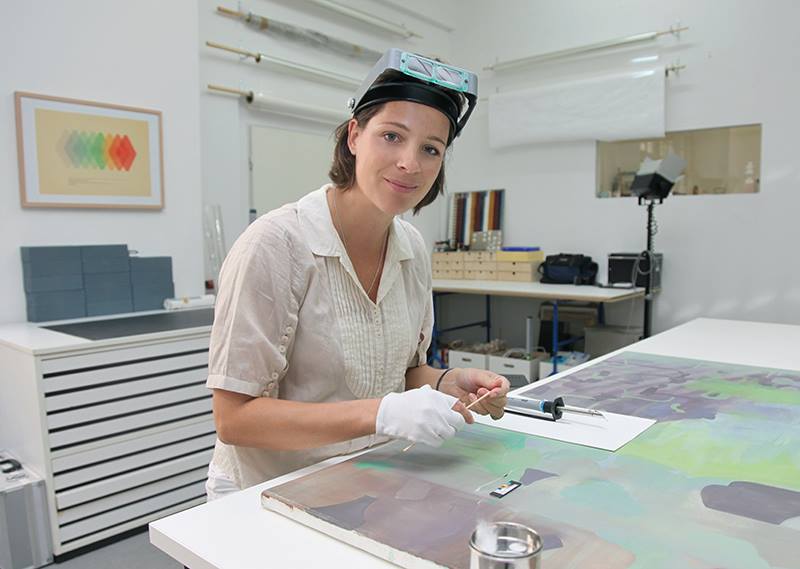empathy
In Focus: The Life Of An Art Conservator

Artparasites has covered a lot of interesting characters in the art world: from disgruntled gallery girls, eccentric collectors, artists who are constantly seeking protection, and more. Yet, where are those unsung heroes who have yet to see the spotlight? One of these overlooked professions is the art conservator. These people are some of the most creative, intelligent and essential personalities that affect the art world perhaps more than we'd like to admit. Last week, I had the fortunate chance to meet Katharina Martinelli, a contemporary art conservator based here in Berlin. Between preparing work for Art Basel and returning from the Venice Biennale's exclusive vernissage, I caught up with Martinelli in her Kreuzberg studio where she shined a light on her elusive practice.
Come Hell And High Water
The year is 1966 and you’re in Florence, Italy. It's early November, so the leaves have fallen to the ground and you've adopted to wearing a jacket for the changing weather. Unfortunately, the last month has seen high amounts of rainfall and the locals fear that the River Arno will suddenly swallow Firenze. Finally, on the 4th of November, your worst nightmare is realized as the precious architecture, art and manuscripts tucked away within Florence's venerable alcoves are severally damaged by the rising floodwaters.
FLOOD YOUR GALLERY WITH SOCIAL MEDIA BUZZ!
JOIN THE SWARM TODAY!
Some of the worst harm is done to a gigantic crucifix created by Cimabue of Santa Croce. Finished in the 13th century by the Italian painter and mosaicist, it would take a team of crafty conservationists to bring this titanic cross to its former glory. Thanks to The Venice Charta that designated rules to art conservation only two years earlier, this job would become an historic example of the importance of art restoration.
Katharina Martinelli, a German-born art conservator, is reminded of this great reconditioning of Cimabue's crucifix whenever she's in her studio. Inside her sunlit atelier are a few large tables that serve as beds for numerous works ranging from contemporary paintings to Baroque portraits. In a large cabinet near the entryway are several pigments, glues, and chemicals that would lead one to believe that this was a science lab reserved for dangerous experiments. These, however, are the tools of the trade for the average art conservator.
Martinelli has been working in the business for 15 years since completing her A-levels in England in 1996. Following several years of internships in Germany, abroad, and her studies at the Academy of Fine Arts in Dresden, she received the coveted degree of Masters in Conservation and Restoration of Fine Arts. While she spends her days working on some of the world's most priceless artifacts, it was in New York that she worked on an artwork that even she was too nervous to touch.
"It was a piece by Yves Klein," she tells me one afternoon over coffee, "His work is actually really powdery which is why it's behind a big piece of glass – at any moment the wrong breath could damage the work." Beyond that, I think to myself how specific Klein was about getting the perfect hue of blue. I can only imagine how much of a headache it might have been to duplicate his famous shade of azure.
Believe it or not, it's actually the contemporary artworks that are the hardest to restore. After Rauschenberg utilized a dead eagle and Chris Ofili painted with elephant dung, conservationists had to continually develop new ways to treat an artwork. This is why whenever Martinelli receives a new piece of art to restore, there's always a new technique she needs to establish.
"There are so many things you can learn from artists; you really need to understand the artwork before you can start treating it," she explains. Among the titans she has had to perform her magic on are pieces by Seth Price, Urs Fischer, Kai Althof and more. She says that it's the monochrome work by Richard Prince or Katharina Fritsch that are the real challenges when they come to the studio: "The important thing is to keep the artists' intention alive in the works."
Like most professions, her job has a busy season and right now, between fairs and biennials, she has had her hands full. Last week, for instance, with gallerists rushing to get works to cities like Hong Kong, Basel, and New York for fairs, she had up to fifteen pieces in her studio. Thankfully, she assures me that her job is something that she loves to do. Of course, who could doubt her when the profession also includes traveling the world and looking at great art everyday? So just keep this in mind the next time you visit a museum or gallery: although the name next to the painting may be why you're there, it's people like Martinelli that help these works of art stand the test of time.
Article by James Shaeffer
Be the first to write a comment.
Your feedback





